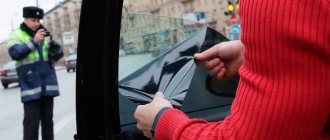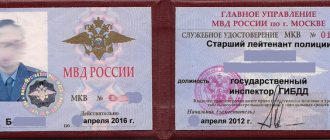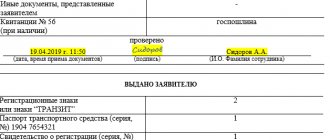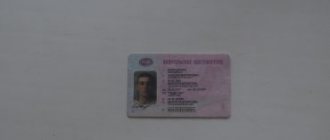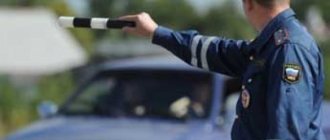Order on public roads directly depends on how correctly road users communicate with road patrol inspectors. In order to prevent unpleasant situations in advance and defend your rights, you need to know how to correctly communicate with people in uniform. There are legal norms on this issue, as well as practical developments, which serve as a brief reminder to the driver when communicating with the traffic police. As always, you need to start with legislation, that is, theory.
Communication from the point of view of the letter of the law in the event of a traffic violation
Firstly, both sides of the communication are equal, so the car owner is obliged to treat the civil servant courteously. And he, in turn, must be no less polite, courteous and objective. At the same time, there should be no personal hostility in the conversation, not to mention the negative impact of a bad mood. Violation of this “iron” law on the part of the driver - this means rudeness, use of swear words, etc. - and regardless of whether the Rules were or were not violated, will have a bad effect primarily on him.
Punishment for insulting a civil servant:
if there were no unauthorized persons or witnesses - an administrative fine of up to 2,500 rubles, an alternative option involves arrest for 15 days;
the presence of strangers increases the penalty to 40,000 rubles. or 360 hours of correctional labor. In some cases, the period of correctional labor may be 12 months.
Therefore, in the event of a potential accident, it is better not to argue with the traffic police officer, and the driver should fill out his part of the protocol. In this case, the car owner has 2 options: agree with his violation and sign that the fine will be paid within 70 days, or not admit to the offense and challenge it within 10 days. In the second case, you should try to collect evidence of your innocence.
However, there are cases when the owner of the car is absolutely confident of his innocence, and the guard, to put it mildly, in a conversation bears little resemblance to a traffic police officer. There is only one thing left to do here - try to behave as calmly and confidently as possible. And, of course, do not make retaliatory attacks, otherwise in the future it will be much more difficult to defend your case in court.
Rules of driver behavior
There are no regulations that would directly indicate to drivers how to communicate with traffic police officers. The only thing is that when issuing a driver’s license, citizens receive a “Memo for interaction with the traffic police inspector,” which indicates the basic rules for such interaction. So, it indicates the possibility of video recording a conversation, the correct procedure for inspecting a vehicle, and so on.
In addition, taking into account paragraph 43 of the Administrative Regulations of the State Traffic Safety Inspectorate, which obligated traffic police officers to behave politely and tactfully towards road users, we can conclude that a motorist should behave in the same way. Moreover, in most cases, when a driver tries to intimidate an employee with threats, connections, or video filming, this does not lead to anything good. An inspector can find a lot of reasons for temporarily detaining a vehicle: inspection, checking documents against a database, checking the driver against a database of various government services, etc. Based on this, a driver who has not violated anything and who is confident that he is right is recommended:
- Address the traffic police officer exclusively politely;
- Carry out all his orders (if they do not go beyond the scope of his authority);
- Record the employee’s actions on a video camera if they are unlawful.
Otherwise, if an insoluble conflict situation arises, in accordance with paragraph 51 of the Regulations, the employee is obliged to call the duty station and call the investigation team of responsible officials to the scene of the incident. In addition, the car owner himself has the right to call the duty station. According to paragraph 52 of the Regulations, the traffic police inspector is obliged to provide him with the appropriate telephone number upon first request. Also, the telephone number of the duty station is always indicated on the patrol car.
A road user has the right to demand from the inspector an explanation of the legal acts on the basis of which he is held accountable (or on the basis of which he was stopped or detained). At the same time, the traffic police officer is not required to carry and show the driver copies of regulations and internal orders. Thus, if a vehicle is stopped due to a special operation, the inspector only verbally informs the car owner about the reason for the stop. He should not show the order on the basis of which the operation is carried out. If you want to check the legality of such a special operation, the driver can always call the traffic police duty station.
Communication in practice
All experienced drivers know how to behave with a traffic police inspector, but beginners, as a rule, make a lot of mistakes. For example, they do not stop immediately or not at a specific place indicated by the inspector. Such actions are often interpreted as a refusal to stop and are punishable by a fine, although there is a clear stopping algorithm that has been developed over the years in accordance with all the rules.
Immediately after a clear signal from the traffic inspector, the driver is obliged to stop immediately. At the same time, the traffic police officer is also obliged to indicate the specific place where the vehicle will stop.
If the car stops at dusk or at night, the driver can communicate with the door closed or even locked - this is prescribed by law.
The most prudent car owners turn on the voice recorder before stopping and dictate the time and place where they were stopped by the traffic cop. You can also use a DVR for these purposes, but a voice recorder has the advantage of being hidden in your pocket. And we must remember that in case of disagreement, both parties have the right to use audio and video equipment.
The standard driver's reminder when communicating with the traffic police also recommends that in order to communicate, you need to open the side window slightly and write down or remember the name of the traffic police officer, his rank and badge number.
After his introduction, the person in uniform is obliged to notify what is the reason for the stop. And only after that, according to the law, he has the right to demand documents from the driver. However, you must always remember that it is not at all necessary to hand over your driver’s license or registration certificate for the car - they can be applied to the glass or simply shown in the window. If the other party demands by order that documents be handed over, then such demands can be legally refuted.
By the way, the list of reasons for stopping is also strictly regulated, and it is also better to know it thoroughly:
violation of traffic rules by the driver or passengers in the car;
checking the driver's documents;
assumption that the vehicle has been stolen and is wanted;
preliminary information that the car owner or passengers are the initiators of an accident or other illegal act;
providing assistance to a traffic police inspector or other road users;
if the driver or passengers witnessed the accident, it is necessary to interview them;
notification of a ban on further movement or other information related to the safety of the route.
Need to know!
If the inspector offers to simply get out of the car, then the driver has the right to refuse this.
To demand such actions, a person in uniform must present compelling arguments, including: a technical malfunction of the car that must be immediately corrected;
the employee’s intention to conduct a search - but, again, there must be compelling reasons for this;
suspicion that the driver or passengers are drunk or are violating the law;
intention to involve the car owner as a witness;
The traffic inspector is sure that the driver poses a threat to him.
Obviously, this list is quite ambiguous and “blurred”. Therefore, from a purely psychological point of view, to create a comfortable atmosphere, it is better to talk outside the car. However, as for the offer to transfer to a traffic police car, it is permissible to simply ignore it. Moreover, all people sitting in the car are legal witnesses who have every right to be present both when communicating with the traffic police representative and when filling out the protocol.
Seven tips on how to communicate with a traffic police inspector
We publish seven tips on how to communicate with a traffic police inspector
1. At the request of a traffic police officer, you must stop, but you are not required to get out of the car . Three documents are required for you: a driver’s license, a car registration certificate, and an MTPL policy (clause 2.1.1 of the traffic rules). Rights must be of the appropriate category and not expired.
A driver who is not the owner of the car must be included in the policy, or insurance must be issued for all drivers without restrictions.
2. The traffic police inspector is obliged to introduce himself (position, rank, surname) and show his service ID at your request, without letting go of it (clause 20 of the Administrative Regulations of the Ministry of Internal Affairs). You can write down his badge number. And find out the reason for the stop.
3. You have the right to make a video or audio recording of your communication with the traffic cop. And he has such a right (clauses 24, 25 of the Administrative Regulations of the Ministry of Internal Affairs).
Changes made to the regulations last year oblige State Traffic Inspectorate employees to notify the driver (and others present) about the use of video and sound recording equipment, including the DVR installed in the patrol car. That is, he can film your dialogue. And I must warn you about this.
4. Do not make excuses or make up legends, but demand evidence of your guilt (Article 49 of the Constitution of the Russian Federation, Article 1.5 of the Code of Administrative Offenses of the Russian Federation). Namely: the results of photo and video recording, witness testimony. And when drawing up a report, the inspector is obliged to read you your rights.
5. If a dispute or conflict arises, do not give explanations or testimonies . In the protocol write: “I do not agree. I demand a lawyer” (Articles 48, 51 of the Constitution of the Russian Federation).
— The defense attorney is allowed to participate from the moment the case of an administrative offense is initiated, that is, already when the protocol is drawn up. His absence when drawing up the protocol is already grounds for canceling the verdict of the traffic police or the court, insists lawyer Leonid Olshansky.
6. Any of your passengers, be it a colleague or a wife, is a witness (Article 25.6 of the Code of Administrative Offenses of the Russian Federation). Their data must be recorded in the protocol.
“The inspector drawing up the protocol is not a witness, but an accuser, because combining procedural functions is unacceptable,” explains the lawyer.
7. Use a DVR. The recording will help you prove your innocence when communicating with the police commander or in court. Now, in the event of an accident, State Traffic Inspectorate employees must take measures on the spot to ensure the safety of video recorders that could record the circumstances of the accident. Naturally, you need to make sure that the inspector makes an entry in the protocol that he confiscated the DVR memory card.
The policeman is obliged to introduce himself and present his official identification at your request; its form itself does not mean anything. form
Photo: Andrey GRECHANNIK
LAWYER'S ADVICE
Leonid Olshansky, honorary lawyer of Russia, vice-chairman of the Russian Motorists Movement:
“Don’t rush into dialogue”
— If you are driving, for example, along a wide city avenue, and an inspector whistles from the sidewalk or from the “glass” of the traffic police post, then it is not at all obvious that the policeman’s signal is touching your car . If the inspector is standing right on the roadway and almost lunges at the hood of your car, or your car number is announced through the speaker, then you definitely have to stop.
But this does not mean that you need to brake by sharply pressing the pedal to the floor. Try to stop smoothly, increasing the distance if possible . And don’t get out of the car, wait until the inspector comes to you. Firstly, this maneuver will be safer for you, and secondly, during the time he approaches the car, all possible witnesses from traffic in both directions will disperse.
Usually the inspector introduces himself quickly, but you are in no hurry to immediately hand over the documents to him. First , politely ask him to show his official identification . And not just for one second “for show,” but so that you can read his name and position, making sure that in front of you is actually a policeman. Only after this start communicating.
And try to always use a DVR . All codes say that any documents and materials can be used for your protection. A video that proves you are right will help prove your innocence in police proceedings or in court.
VERBATIM
It's not okay to be rude
“In a conversation with road users, an employee must be polite, objective and tactful, address them as “you”, present their demands and comments in a convincing and understandable form, excluding the possibility of erroneous or ambiguous understanding of them, show calmness and restraint... Explanations... must be given without moralizing, convincingly and clearly with reference to the relevant requirements of the Traffic Rules and other regulatory legal acts” (paragraphs 19, 23 of the Administrative Regulations of the Ministry of Internal Affairs).
IMPORTANT
Let's not ambush!
It is impossible to hide a patrol car from drivers in the bushes; the vehicle must be placed “in a stationary position in such a way that it is clearly visible to road users.” “The use of vehicles other than patrol cars is not permitted,” this is written in black and white in the regulations (clauses 41, 43 of the Administrative Regulations of the Ministry of Internal Affairs). However, it is allowed to install mock-ups and mannequins to prevent violations.
WHAT IF YOU ESCAPE?
Should not be doing that. If you do not stop at the request of the inspector or refuse to hand over documents to him, he has the right to initiate a case for “disobedience to a lawful order or requirement of a police officer,” this threatens with a fine of 500 to 1000 rubles or even arrest for up to 15 days (clause 23 of the Administrative Regulations of the Ministry of Internal Affairs , part 1 of article 19.3 of the Administrative Code). The inspector has the right to pursue with the “flashing lights” on and stop forcibly, up to placing trucks on the road or firing a weapon (clauses 73, 74 of the Administrative Regulations of the Ministry of Internal Affairs)
Documents to refer to:
Traffic rules - Traffic rules.
Code of Administrative Offenses - Code of the Russian Federation on Administrative Offences.
Adm. regulations of the Ministry of Internal Affairs - Administrative regulations of the Ministry of Internal Affairs of the Russian Federation for the execution of the state function of control and supervision of compliance by road users with requirements in the field of ensuring road safety.
Photo: Dmitry POLUKHIN
What is a traffic police officer required to do?
Firstly, when a car is stopped for violating the rules, the traffic police officer is obliged to indicate the traffic rule that was violated. Secondly, when the purpose of the stop was the participation of the driver and passengers as witnesses and witnesses, the traffic police representative must briefly and clearly inform citizens about their rights in this capacity.
The rules of conduct for a traffic police inspector require the presentation of an official ID if the driver considers his actions to be unlawful or the civil servant was unable to name a specific point of the traffic rules that was allegedly violated. The driver also has the right to record the guard’s data. And he, in turn, is obliged to name the telephone numbers by which the car owner can contact to appeal the actions of the inspector. Sometimes inspectors simply call the number of the person on duty who has the legal right to accept the complaint - and this is completely acceptable.
When can a traffic police officer stop a driver?
Orders of the Ministry of Internal Affairs No. 185 and No. 329 define situations when stopping a vehicle is justified:
- The car violates traffic rules and can cause an emergency. Specific incorrect actions must be identified visually or using specialized technical means. When a driver applies the brakes, the officer must clearly state the violations the person behind the wheel is accused of committing.
- The highway patrol service received a message about the possible involvement of the driver in the crime. If the traffic police officer received the relevant information through official channels, the car was stopped due to the provision of relevant testimony by third parties or because of suspicion at other traffic police posts, the inspector is obliged to clearly state the reason and name the offense of which the driver is suspected. A stop is lawful only if there are grounds to suspect a person of committing a serious crime, participating in an accident with consequences, or violating traffic rules, for which administrative liability arises.
- The car the driver is driving is similar to a vehicle that is wanted or stolen. An inspector can also stop a person if he has reason to believe that the vehicle is planned to be used to commit illegal actions.
- There is a possibility that the driver or passengers have information about a crime or accident that they witnessed. In this case, the stop is legal, since the inspector legally collects witness statements.
- Attracting witnesses to conduct an inspection of an already stopped car.
- A clearly defined official need for the temporary use of a vehicle or driver’s services to assist traffic police officers during special operations, as well as interaction with other road users.
- Checking the availability and correctness of driving documents. Depending on whether there are passengers or a certain cargo in the cabin, the traffic police officer has the opportunity to request the presentation of various papers. The driver must have the right to transport any cargo that is in the vehicle, as well as accompanying documentation, a certificate of ownership and control of the vehicle. If there are passengers in the cabin, the inspector may request the presentation of their passports for identification. An employee has the opportunity to stop the vehicle in order to view documentation only at a checkpoint or stationary posts.
- Establishing the identity of the driver, the list of transported goods when executing the order of the head of the Ministry of Internal Affairs or the State Traffic Safety Inspectorate.
Attention! Other cases of stopping a vehicle are unlawful. If a traffic police officer does not give clear reasons or lists unlawful grounds for stopping a car, you can accuse him of violating official discipline. To prove that you are right, it is advisable to use a video camera if you suspect that a vehicle was stopped illegally.
Violations committed by State Traffic Inspectorate inspectors
The absence of a badge is an extremely serious violation.
Travel during working hours other than on official transport.
Intentionally hiding a car from view - behind bushes, trees, houses, etc.
Lack of flashing lights on service vehicles. If the traffic police car is parked in a prohibited place or other traffic rules are violated, the inspector must be held accountable under the law as an ordinary driver.
Presenting the car owner with offenses that do not exist in the law or inventing them on the fly. In such cases, the driver should make a note in the protocol “sergeant full name extorting money.” Then the probability that such a protocol will not be implemented is almost one hundred percent.
A rather rare phenomenon, but it also occurs - excessive aggression by a traffic police officer. Everything is simple here: the driver needs to call the helpline or submit an application to a higher authority.
Competently filling out protocols is the basis of your protection
In the question of how to behave if stopped by a traffic police inspector, in terms of drawing up documents about the violation, there is a “golden” rule: a representative of the authorities must prove guilt, and not vice versa, the car owner must prove his innocence. Secondly, explanations, like the driver’s signature in the protocol, are his right, but not his obligation. Accordingly, when the protocol contains the words “Signature of the violator” in a certain column, the word “violator” should be crossed out and “driver” should be written on top. This is a very important point, which means that the owner of the car denies his guilt. Also, if there is free space, it is better to write “disagree” - and then during further proceedings it will be clear that the person behind the wheel did not agree with the actions of the inspector from the very first minute. And so that in the line “witnesses” over time the full name does not appear out of nowhere, it is recommended to put a broad signature in the empty column so that there is no empty space left. You also need to know about the features of specific types of protocols.
Speed limit violation.
As stated above, inspectors must prove that the speed limit is exceeded. And if the driver is presented with a “hairdryer” with incomprehensible numbers, you can safely challenge the protocol. Because the radar should indicate that the speed was recorded specifically for this particular vehicle, and that the indicators were taken right now, and not last week.
Unfastened seat belt.
As a rule, it comes to the fore when the traffic police officer has run out of arguments in favor of another, more serious offense. However, driving without a seat belt also needs to be proven - by presenting a video recording or witnesses, and immediately. If this is not the case, then you can simply state: “Yes, of course, you can’t drive unbelted. But I just took off my belt while you were walking to my car."
Contaminated signs.
According to the 2021 rules, it is prohibited to drive a car with dirty license plates that are not visible to a traffic police inspector from a 20-meter distance. Of course, in the dark. However, to fix this violation, it is necessary to create conditions close to the specified ones, which is never done in practice. Therefore, if the driver behaves confidently and does not ingratiate himself, the matter is limited to a request to wipe the “plate”. And that's it - no fine.
Driving instructors are always up to date
Thanks to following the instructions, the driver can avoid fines, deprivation of rights and other troubles when communicating with the traffic police. However, in Russia, traffic rules have changed so rapidly in recent years that even professional drivers do not always have time to keep track of them. And only private driving instructors, who, by virtue of their belonging to “road teachers”, are always up to date with the latest events, are able to study the legislation on a daily basis. Therefore, taking a lesson or two from them is always beneficial!
| Tweet |

